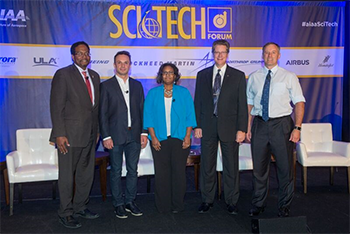Digital Disruption in Aerospace Written 9 January 2018
Panelists: Moderator Darryll J. Pines, dean of the A. James Clark School of Engineering, University of Maryland; Andreas Bernhard, chief engineer, CH-53K, Sikorsky Aircraft Corp.; LaNetra Tate, program executive, Space Technology Mission Directorate, NASA; Jack O'Banion, vice president, Lockheed Martin; Brendan Iribe, co-founder, Oculus
by Tom Risen, Aerospace America staff reporter (2017-2018)

Digital innovation that changed daily life with smartphones and cloud computing is now breaking technical barriers in space and aviation, technologists explained Jan. 8 during the “Digital Transformations Disrupting Aerospace Business Models” panel at the 2018 AIAA SciTech Forum in Kissimmee, Florida.
The design process for aircraft is one of the main digital disruptions in the aerospace sector. The CH-53K King Stallion helicopter that Sikorsky is developing for the U.S. Marine Corps is the Lockheed Martin subsidiary’s first production aircraft built with a completely digital, paperless design, said Andreas Bernhard, the helicopter’s chief engineer at Sikorsky. Looking ahead to the 2020s, Bernhardpredicted, “our most profitable product is no longer going to be the Black Hawk, but the CH-53K.” New technologies on the CH-53K also include composite rotor blades that he said “generate enough lift to carry an empty Black Hawk,” a transmission with improved power density than previous generation Sikorsky helicopters, and digital engine controls in the cockpit.
Digital assistants that are becoming more widely used on smartphones also have great potential to guide aerospace engineers. A “Siri for designers” akin to the Apple digital assistant could give real-time feedback on the effect of different options, including materials, said Jack O'Banion, vice president of strategy and customer requirements with Advanced Development Programs at Lockheed Martin.
“There are optimizing routines out there now, but if you’re not careful with the human too far removed from the design loop, you could walk through design choices that you may have preferred to make,” O'Banion said.
NASA is also keeping flexibility in mind when designing its autonomous technology. The semi-autonomous, free-flying robot Astrobee that NASA’s Ames Research Center is developing to assist International Space Station astronauts in tasks like inventory will free up valuable time on the station. The disruptive feature of it, however, is that it can be upgraded with code for scientific tests and improvements from people outside of NASA, said LaNetra Tate, program executive with NASA’s Space Technology Mission Directorate.
Virtual reality and augmented reality also have the potential to change aerospace training, design, communication and visualization. Brendan Iribe, co-founder of California-based virtual reality hardware developer Oculus, said the world is at the beginning of a “virtual age,” with the growing availability of devices, including the Oculus Rift headset. In decades to come, he said, rovers on Mars could scan their surroundings to give people a chance at interacting with the red planet in a virtual simulation.
